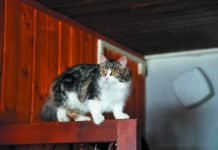You’d think the pupils of house cats would be similar to those of the big cats in the wild, like lions and tigers. But their slit-like pupils are actually more like the pupils of snakes and crocodiles, researchers found when looking at the pupil shapes of 214 different types of animals. Why is that?
It presumably has to do with the fact that cats, snakes, and crocodiles are predators that are pretty close to the ground and ambush their prey to pounce on it. For animals who go after their meals that way, it’s very important not only to be able to see their prey very clearly. They also need to be able to judge with incredible precision the distance of the prey so they don’t over- or undershoot the mark and let the animal get away. Slit-shaped pupils appear to be an evolutionary adaptation that allows for those two things simultaneously.
The tight slits to which a cat’s pupils can narrow give them remarkable control over the amount of light that enters the eyes and keep it at just the right level for bringing into very sharp focus the contours of, say, a rodent. Consider that a cat’s pupils can expand 135-fold because of the way the muscles work on either side of them. That allows them to let in an abundant amount of light when light is scarce or keep too much light from entering when it’s bright out so glare won’t get in the way of keeping their eye on the “prize.” (Our own pupils can only expand and contract a paltry 15-fold.)
At the same time, while the slits in a certain sense keep the pupils small, they still remain large from top to bottom, making them vertically tall, so to speak. That in turn helps to blur the foreground in front of the prey as well as behind it. The blurriness both in front of and behind the desired object is what allows a cat to estimate its distance with precision. Think of the way a photographer will set a wide aperture on his camera to capture the bride and groom in sharp focus but leave the scenery around them looking hazy.
Long story short: the degree to which the pupil can narrow allows for incredible focus; its height, for determining how far away the prey is. Predators like lions and tigers, by contrast, have round pupils, like people. They ambush and pounce, too, but they have more distance to cover to catch up with a zebra or antelope than a cat does to get to a mouse, so the whole focusing thing works differently for them.
A note on the pupil shape of prey animals
The researchers also found that the pupils of prey animals like sheep and horses are like horizontal bars. And their eyes are closer to the sides of their heads. That is, they have incredible peripheral vision, which lets them scan the horizon for predators so they know when to stop grazing and run.
Nature: It thinks of everything.



